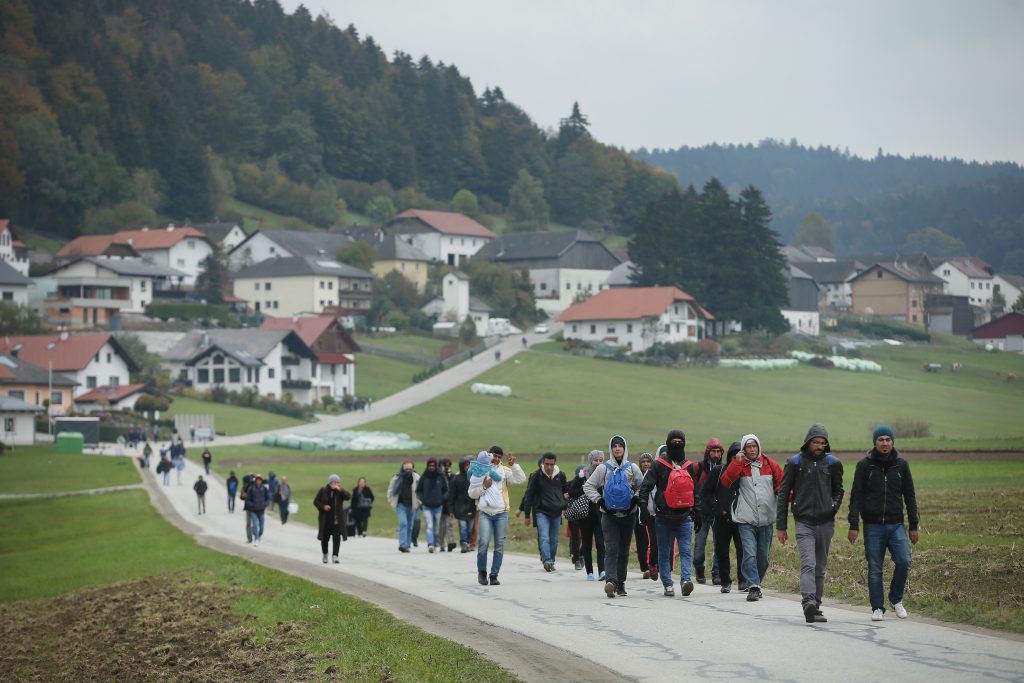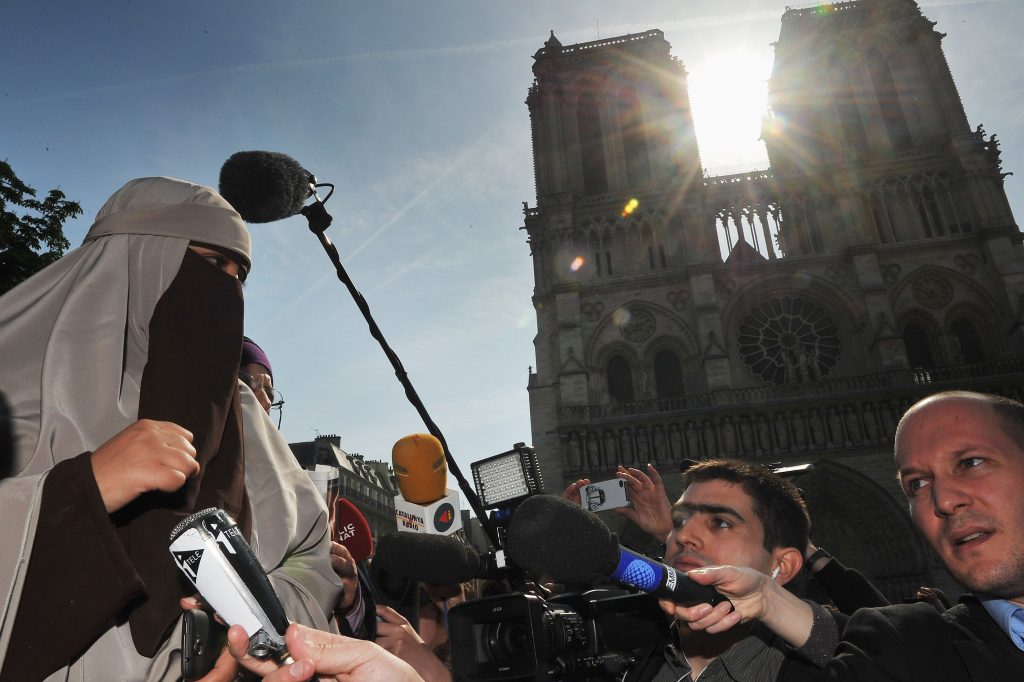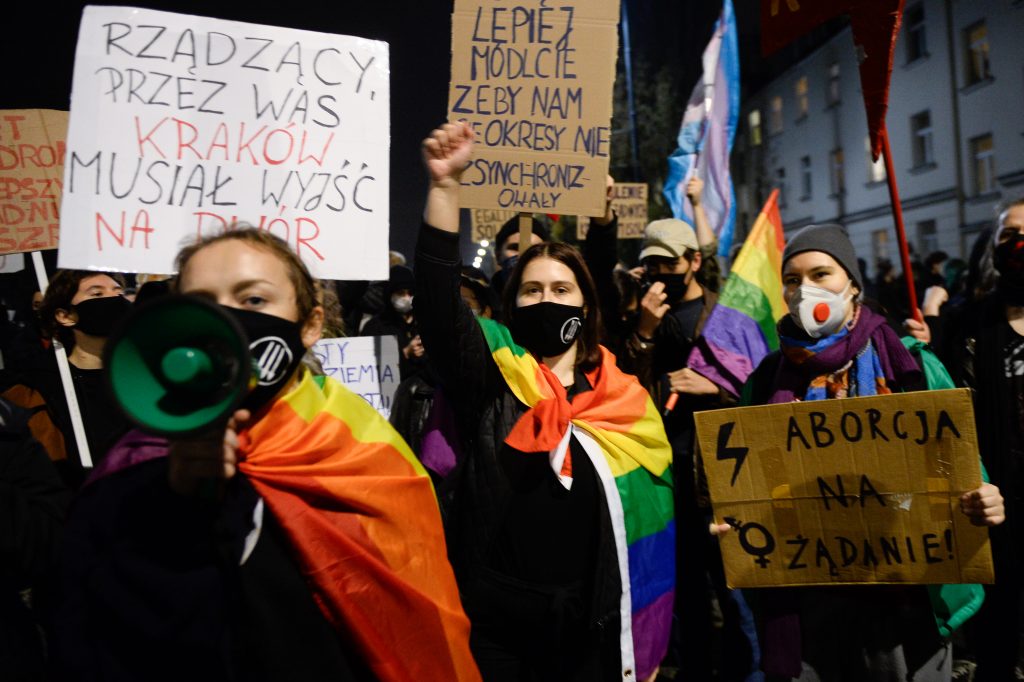In 2016, right-wing media in Germany erupted with alarming revelations about an alleged epidemic of Middle Eastern refugees raping German women. The most salacious reports described “ISIS Sex Jihadists” on the loose.
Eventually it became clear—as Der Spiegel and other publications revealed—that there was no “refugee rape epidemic.” A few headline-grabbing cases of assault, some of them involving refugees, had been blown up into a false narrative that reinforced an existing right-wing campaign against immigrants and asylum-seekers. But fact-checking didn’t dislodge the narrative that already had taken hold.
Similar frenzies frequently grip contemporary societies, often with little or no factual basis. Scholars have a word for this type of mass hysteria: a moral panic. And today, moral panics are a prominent feature of the political landscape around the world.
This roundtable of academics and activists uncovered surprising transnational consistencies and resonances when it compared the phenomenon of moral panics across regions, in Europe, North America, and the Middle East and North Africa. A few common features of moral panics emerge. Most moral panics are intentional, invented, or fanned by opportunistic actors. Moral panics are powerful tools for manipulation, and reactionaries exploit them to rapidly construct social coalitions that might not otherwise coalesce. The victims of moral panics are almost always marginalized groups, who are cast as a threat to society’s values, interests, and stability. And groups around the world seem to borrow from each other’s deployment of similar techniques to create and leverage moral panics.
Examples of moral panics with these features abound. Around the world, there are panics about “deviant” sexualities. Such moral sex panics often target LGBTQ people—whether in authoritarian states like Egypt or in countries with strong right-wing movements, such as the United States, where Republicans have created a furor around transgender people accessing gender-appropriate bathrooms. But moral sex panics can affect people of any sexuality, including heterosexual refugees and nonwhite males, as in the German case. And moral sex panics can target heterosexual women, as in Egypt, where, in 2020, several women were sentenced to lengthy prison terms for posting supposedly immoral TikTok videos.
The panics explode over ideas, as well. Everywhere from Poland to the studios of Fox News, reactionaries have recast progressive ideas about the nature of gender as a militant “gender ideology” that will destroy traditional values. A similar panic has spread concerning critical race theory—an academic analytical framework that American right-wing leaders have seized on, with the help of plenty of disinformation, to fight against anti-racist education.
Comparing these moral panics reveals that they are not solely or even primarily about morality. In case after case, they are shown to be about power—more policing of the marginalized; stifling social and economic change that would cost the elite; fighting democratic reforms; and redirecting grievances toward scapegoats. Governments and factions often use moral panics to mobilize support for preexisting political projects.
Economic inequality, the weakening of state support, and the power of social media have made contemporary moral panics more potent. Understanding the logic of moral panics, roundtable participants show, is a first step toward neutralizing their dangerous weaponization against progress and rights.
The discussions in this roundtable represent the views of the participants and do not necessarily reflect the positions of The Century Foundation.
Naira Antoun: Maya, your book Sextarianism (Stanford University Press, 2022) locates moral panics within a framework of securitization. Can you say a little more about that?
Maya Mikdashi: Moral and sex panics are an important part of the conversation—they’re very effective transnational phenomena that bring our contexts together. Moral panics also span scale, from enabling foreign invasions and occupations to police crackdowns on vulnerable communities all over the world. Moral panics—which spread the gamut of sexuality—achieve a lot of things. In Lebanon, for example, sex panics about Syrian refugees achieved curfews, and the requirement of passes to move through certain areas. In other words, they securitize mobility and play an active role in racializing Syrian refugees and migrant laborers, through discourses of sexual and gendered danger.
Moral and sex panics are not only deployed by states, and are not only deployed in a top-down way. They can also be deployed in anti-state rhetoric or discourse. A few years ago, for example, there was a successful activist campaign against anal examinations that the Lebanese state was giving men suspected of having sex with men. Of course, queer sex is often securitized through moral and sexual panics, and the transnational legal framework of “public morality” has often been used to police queer sex across the world. In the Lebanon case, what was interesting—and I analyze this in my book Sextarianism—is how human rights and media discourse around anal examinations in Lebanon also engaged in the discourse of a moral, sexual panic that framed the state as perversely invested in sexually torturing the male body.
“In Lebanon, sex panics about Syrian refugees achieved curfews, and the requirement of passes to move through certain areas.”
However, what precipitated this specific episode was a crackdown on refugees and migrant workers in which anal exams and sexuality were used as a mechanism to securitize residency, class, legal status, race, and sex. Yet the campaign against these examinations did not understand the sin of the state to be the securitization and torture of refugee and migrant laborers. Instead, the transnational campaign framed the examinations as the torture of men suspected of having sex with men, which of course they were. However, if we center race, class, and legal status, anal exams also emerge as one of many violent technologies deployed by the state to securitize the borders of national belonging.

Chapter five of my book introduces what I call “the epidermal state,” and I center violence, security, and sovereignty through tracing the use of hymen and anal exams, and the different ways that these exams function legally and structurally in terms of different arms of the state and, in the case of hymen exams, parastatal actors such as the hetero-patriarchal and hetero-sectarian family. Here, I’m trying to put queer and straight sexualities into conversation through the rubric of securitization, and to think about sovereignty in terms of the everyday experiences of violence. I argue that these exams are really about the state producing itself as a bounded, sovereign body—with the ability to materialize and handle sex, the body, and their meaning. When we talk in binaries of citizen and noncitizen, we assume that securitization happens to the noncitizen. But citizenship itself is a mode of securitization.
I’m frustrated by how hymen exams are not really put front and center in our analysis of violence, securitization, and sexuality. So an animating question is, Why has there been a public campaign against the use of anal exams, but thus far no campaign about hymen exams? I think the answer has something to do with how we think about sexuality, specifically, how “sexuality” is sometimes collapsed with queerness, and the fact that we don’t think enough about women’s sexuality as a political site for the articulation of state power, both in the Middle East and transnationally.
A Range of Victims
Lobna Darwish: It’s true that moral panics can have a variety of targets. In 2020, a case arose in Egypt that came to be known as “the TikTok girls.” Several women were accused of inciting debauchery for challenging Egypt’s so-called “family values” because of supposedly indecent photos and videos they posted on TikTok. These women posted videos in which they danced and lip-synched—regular TikTok material. Five of these women were sentenced to two years’ imprisonment for promoting immorality. One was handed down a ten-year prison sentence on charges of human trafficking.
What the case was really about was the securitization of class. While it didn’t feature in a lot of the international coverage, all of these women were from lower middle-class families. And in Egypt, the assumption is that such women should dress conservatively. There’s a sense that, more than taking a stance against supposedly provocative media, the state was actually policing the TikTok girls’ presentation as lower-class women. It’s almost comical—the state went to extreme lengths to say, “Crop tops are off-limits for poor or lower middle-class women.” So yes, moral panics like this have a gender aspect to them, but they’re ultimately about class, as well.
There is a social consensus built around these moral panics. Moral panics are quite different from other tools used to attack vulnerable groups, because they allow for the construction of coalitions between groups that wouldn’t necessarily get along otherwise. In Egypt, we’re seeing a diversity of resources and discourses organized around defending patriarchal privileges (not primarily religion, as in the past), all coming together around moral panic. That allows different kinds of people who don’t usually get along to come together to defend their privilege.
The way that the state comes in is very interesting. You have women organizing and there is a very crude, misogynistic response. The state comes in, not only in support of the reactionary sides, but also to stop anyone from organizing. In other words, the state intervenes in a real social clash, and its intervention is moral panic, which it uses to stop the conversation.
“There’s an assumption that states only crack down on queer sexualities. The TikTok case in Egypt shows this isn’t always true.”
There’s an assumption that states only crack down on queer sexualities. The TikTok case in Egypt shows this isn’t always true. When I’m on panel discussions, if I mention that this is a crackdown on sexuality, people often assume that the women in these cases are lesbians. I make a point of describing it as a crackdown on sexuality to elicit that moment of surprise or confusion, to avoid the usual parceling off of queer sexualities as being the sole target of state violence and control. I want to highlight that policing of sexuality very much happens to heterosexual women.
It’s interesting that, in Egypt, gender rights activists also treat the issues of hymen exams and anal exams separately, even though they’re really in the same category of abuse. We’re trying to rectify that—it has to do with bringing both straight and queer sexualities into the same framework.
Sexual violence as a moral panic is also deployed as a way to entrench policing. Sexual violence is a defining part of experience for women and others, but the way it is framed as a constant threat is also a moral panic—that all men want to rape, that the only way to protect children and young women (especially teenage white girls, in societies where there is whiteness in its European or American sense) is to police everyone. The first reply to movements questioning policing and prisons is typically a totally sexualized moral panic, particularly about the rape of children and young white women.
Sabiha Allouche: Sarah Higazy was a young lesbian woman who got caught up in a gay moral panic. At a Mashrou’ Leila concert in Egypt in 2017, she and some others flew a rainbow flag—the front man of the Lebanese band is openly gay. She was arrested and spent some time in prison, before dying by suicide, in 2020 in Canada, where she was living in exile.
An interesting question is whether, in the case of Sarah, the abuse and torture that she suffered was more representative of the oppression she experienced because of her status as a woman, or because of her status as a lesbian. There’s a brilliant 2018 article in the Oxfam journal Policy and Practice, called “Reconceptualizing and Contextualizing Gender Sexual Rights in the MENA Region: Beyond LGBTQI Categories.” It warns us that we should be careful about how we sometimes conflate gender identity, orientation performance, and performativity, in the Middle East and North Africa. Because oftentimes, if you’re a lesbian woman, chances are you are going to face a lot of discrimination based on your female status, and not your queerness per se.
Maya argues in an article (which I really recommend reading) that “moral panics not (only) reflect the country’s social or political realities, they articulate and help shape them especially at moments of deep civil and political unrest.”
Another framework that also helps us to think about moral panics is the work of Lara Deeb and Mona Harb, who tell us to think about the different rubrics under which morality functions. Morality has a social rubric, a political rubric, a religious rubric, and, in the context of Lebanon, a sectarian rubric.
It seems that it’s futile to think about morality outside of a political-economic framework, and it’s imperative to link this framework to precarity as a global issue. Precarity—in other words, economic or material instability—often brings forth moral panics.
A Powerful Political Tool
Naira: Moral panics, as we’ve heard, are a versatile tool. Houria, you’ve written about the campaign in France organized in 2014 by a French-Algerian woman, Farida Belghoul, to keep children home from school for a day to protest the way that schools were teaching gender, which they saw as gender-based brainwashing.

Houria Bouteldja: It’s a good example of the fact that sexual moral panics are also taken up by the subaltern, especially the racialized subaltern.1 For example, there’s the idea that the state wants to turn their kids gay, especially through schooling. The younger generations of subalterns in France are less progressive than the older ones, and the difference is becoming more pronounced. In the vocabulary of the Left, we would describe this as a “reaction.”
Belghoul launched her protest because, she said, the national curriculum wanted to introduce the theory of gender in school. Belghoul said that it was necessary to preserve the masculine and feminine. Her protest was so successful that it caused a wave of panic in many districts.
I would like to try not to give in to contempt and even to try to learn something from Belghoul’s rejection of left-wing values. It’s even possible that her rejection could be turned into something positive that supports a project of liberation.
Indeed, it is difficult to know how we can judge Belghoul’s project and the thousands of people she convinced. It is also difficult to know how we can judge those who voted for right-wing candidates in the name of patriarchal order and security. How can we judge the women who deplore the “death of men,” where a certain feminism would like to see them rejoice? How can we judge those who drift toward the most reactionary ideas and who occupy the lowest level of the social scale?
It is by the yardstick of the thirst for integration that we must judge the degradation of relations between men and women and of a greater intolerance toward homosexuality.
But if I put on my decolonial glasses, I don’t see these issues the same way that a white progressive does. Let’s take the case of the retreat of a fringe of the children of immigration toward “family values” that are so hated by the Left. This retreat reflects a keen awareness of their material interests at a time when the social state is retreating, and when one of the few places of retreat, protection, and solidarity remains the family framework. This framework is admittedly oppressive in certain respects, but it is where one finds protection and affection in the face of the onslaught of neoliberalism. When women deplore the “death of men,” perhaps they are actually ahead of the progressives. Don’t they know better than anyone that without the material help of the men around them, they face precariousness and the needs of their children alone? This is the point of view from which we should judge and appreciate the desperate and tragic participation of all these racialized and poor families in Belghoul’s project.
“If I put on my decolonial glasses, I don’t see these issues the same way that a white progressive does.”
Behind the family conservatism, there is the criticism of the antisocial state. To put it differently, behind each of our regressions, there is a revolutionary dimension, in the sense that those regressions contain the critique of the state, liberalism, and imperialism. This regression can prolong our servitude and, in the long run, be fatal to us. But it can also become fruitful and revolutionary if we give ourselves the means for it to be. This is what I call fertile regression.
Panic over “Gender Ideology”
Naira: Crusades against “gender ideology” are neither entirely new nor exclusive to any particular region. But the concept has gained traction in recent years. For instance, in Spain and France, opponents of same-sex marriage raised the specter of gender ideology. Poland and Hungary—where gender ideology is very much represented as a threat associated with Nazism and communism—present extreme examples of a phenomenon that is more widespread. In Poland, attempts to curb sexual and reproductive rights were met with mass protests. The authorities used the boogeyman of gender ideology in their anti-abortion rhetoric. Can you tell us a bit more about that, Kate?
Kate Korycki: We can think of Poland as a loose stand-in for what is happening in Eastern Europe more generally.
The Polish protests of 2016 and 2020 were sparked by fresh restrictions on abortion and reproductive rights. I treat abortion rights as the canary in the coal mine, in that their extensiveness allows us to gauge the degree of patriarchal organization of a society. Poland presents a complicated picture, historically speaking: under communism, from 1945 to 1989, abortion was legal, and women had access to employment equity, child support, and free education and health care. None of these benefits may have been perfect, but they constituted an ideational horizon, in which state involvement in social reproduction was taken for granted.
“I treat abortion rights as the canary in the coal mine, in that their extensiveness allows us to gauge the degree of patriarchal organization of a society.”
Many contemporary commentators in Poland claim that the communist provisions instituted a double burden on women, since women were expected both to work and to be homemakers. But these critics forget that working outside and inside the home was not a function of communism, but of patriarchy. The same issue exists for women in the United States, for instance.
In 1993, four years after the end of communism, abortion was effectively banned—its legal availability was restricted to three circumstances: pregnancy as a result of rape or incest, threat to a mother’s life, and fetal abnormality. These restrictions were part of a large-scale retrenchment that also enfolded other rights—like childcare, for instance. Abortions continued, of course, and the number of clandestine abortions was high (to the degree that such figures can be obtained). But the act of abortion itself was not criminalized, even if it was not legal.
Things changed in 2016, when the ruling Law and Justice party (known as the PIS, its Polish initials), criminalized abortion, a move which is now being replicated in the United States. In response to this criminalization, Polish women organized the National Women’s Strike (they were also known as the Black Protests, in reference to mourning). More than 200,000 people marched and half a million went on strike, prompting the PIS to back down from criminalization—though Poland retained the most restrictive abortion law in Europe.
In 2020, the PIS again tried to restrict abortion rights by removing one of its legal grounds. Protests erupted again, this time lasting a week and involving some 420,000 protesters. The protests were the largest since the days of Solidarity (the 1980s trade union movement that helped end Communist rule in Poland). The abortion rights protesters were angry. They came from both rural and urban centers, and the protests brought young people onto the streets.

The connection here to moral panics is the PIS strategy for promoting the party’s agenda. They waged a “war on gender ideology,” which they devised to mobilize the “moral people” of Poland. The PIS invented this idea of “moral people” oppressed by the “evil elites” (also invented) as an electoral strategy. I don’t want to overstate the blame the PIS bears for the assault on abortion—access to abortion was abysmal before the party’s rise, and PIS merely tweaked existing restrictions. But what is interesting and relevant here is how they instrumentalized a moral panic about “gender ideology” for their political aims.
The PIS, the Catholic Church, and others in mainstream Poland present the work of feminists and queer theorists—those who study gender (broadly defined) as a social fact, rather than a fact of nature—as forces of political invasion, an ideological imposition, by foreign, deviant, and hostile forces. In this telling, those who study gender are actually inventing and imposing it. To make such studies even more threatening, the PIS and its allies associate “gender” with the word “ideology,” which in Poland brings to mind both communism and Nazism. “Gender ideology,” in such a presentation, is doubly loaded in a threatening way: gender now stands together with systems presented as existential threats to the nation and state.
The stakes of this strategy, I propose, were the reassertion of maleness and its connection to control and the “natural” right to rule. It also had to do with the reassertion of motherhood as the only acceptable role for a woman. And perhaps most interestingly—and here I credit the Polish scholar Anna Zawadzka for the insight—the strategy meant to reassert family as the only acceptable community in neoliberal orders. This obscure maneuver reveals itself as a way of reinventing deeply stratified belonging, organized along gender lines.
Academic Infighting
Naira: Gender ideology has featured in a number of contexts, such as those in Poland, that Kate has described. The attacks on gender ideology have also targeted feminist and queer scholarship. Emma, you’ve been doing some work around moral panics and academia in the UK.
Emma Spruce: In 2018, three people revealed they had worked on a hoax for about eighteen months. They said they wanted to show that they could get fictitious “scholarship” published as long as it demonstrated an understanding of the literature and aligned with the “moral orthodoxy” of gender and sexuality studies and critical race theory. Seven of the twenty bogus articles they wrote were accepted for publication. The individuals who penned the papers—who turned out to be academics and writers themselves—argued that their hoax showed the political bias of gender studies as a discipline. They have subsequently argued that gender departments should be shut down. Critics of the hoax have pointed out that it undermined the “good faith” assumptions through which academic scholarship is produced, and wasted a lot of peoples’ time. Further, there are some questions around funding—one of the hoaxers had private funding, and he hasn’t revealed its source. But the hoax still captured public attention—dovetailing with a more generalized moral panic about the threat to the “natural order” that gender studies poses. There were also some articles in the press that were largely sympathetic to the claims this group of academics were making.
The example relates to the fact that moral panics are effective political tools, and have been used effectively by both the Left and the Right. There have been multiple incidences of this kind of thing in the last five years or so: In Hungary, gender studies was banned in 2018 on the premise it was an ideology, not a science. In the UK, the Minister for Women and Equalities argued in 2020 that the “equality debate” was being held back by “postmodern philosophy.” Last year, the U.S. Senate voted to ban government funding for CRT. And in Brazil the dissemination of “gender ideology” was criminalized.
One of the questions my colleagues and I are thinking about in a forthcoming chapter we’re writing is to what extent there are transnational connections between these separate panics about gender studies, or whether there is more of a chain of inspiration between them. The lack of clarity about the funding of the journal hoax makes you start to wonder whether what seemed like a puerile incident is actually connected to a broader set of resistances to academic knowledge production.
One of the case studies we are looking at in our forthcoming chapter relates to an incident in 2018, when two “gender-critical feminists” were disinvited from speaking at public events at the University of Essex because of the concern that they would provide a platform for transphobic hate speech. After the dis-invitations were made public, it prompted multiple rounds of reversals and apologies from the university. The University of Essex commissioned an independent review by a barrister, which concluded that disinviting the speakers had been a procedural and legal mistake. The university’s vice chancellor gave a long public statement apologizing to the academics and the wider university community for the harm that had been done to them as a result of the limits of freedom of speech.
But the independent report itself incited critiques, which flagged the irony that this defense of “free speech” called for constraints on academic freedom and students’ right to protest. But the independent report itself incited its own reaction from critics who said it constrained speech. The same vice chancellor came back a couple of months later apologizing for his previous apology, and this time apologizing to trans students and faculty. At this point, the originally disinvited academics threatened legal action and said that the second apology nulled and voided the first.
The incident highlighted a particular intersection of neoliberal university culture and brand management, which makes these tactics—using social media and legal action—very effective. These tactics can cause us to all become embroiled in a process of having quite insular fights. I’m also interested in the echoing of “harm” throughout the episode, and whether there are ways for us to move without that language of harm. Are there better ways to talk about these issues? There has to be a way to not think about resistance in terms of preventing particular scholars having a platform. Instead, we should be refusing to get entangled in these fights, because there is a mutual will to become entangled.
Learn More About Century International
Securing Privilege
Naira: Anna, your work looks at Germany, and Europe more broadly. How do you see the role of moral panics in contemporary Europe?
Anna Younes: A moral panic serves as an archetype in cultural hegemony, which is necessary during crises to secure political hegemony, especially white hegemony, in a capitalist system. Moral panics include, most notably, the War on Terror, sex and gender panics—usually revolving around language—and debates about crime. In a way, Europe, as we know it today, came into existence through moral panics—think of the centuries of patriarchy and witch-hunts, colonial expansion, and the emergence of a global capitalist European monetary system with chattel slavery as a foundational pillar. Moral panics protect the interests of people who benefit from racial capitalism, albeit in different ways and to varying degrees.
It’s interesting to consider the circumstances under which a majority gathers behind the tropes of a moral panic instigated by state powers. Moral panics operate under an “either you are with us or against us” logic, and they aren’t new. But according to the sociologist Stuart Hall, what might be new and concerning is that, since the 1980s, in the neoliberal period, capitalist elites have managed, in a performative sense, to occupy the language of the Left while pushing neoconservative or even right-wing agendas.
“Moral panics individualize politics through personal passions and emotions, and then manifest the latter on a national or transnational policy level as ‘collective will’”
In my work, “performative anti-racism” deflects the moral shortcomings of the nation onto Others, who by their mere existence or thinking (or both), exemplify the shortcomings and frictions of and in political campaigns.
Moral panics also allow us to stigmatize the Other more easily—and are thus an important tool to convince a large part of society to, for instance, go to war against a common enemy. Marshaling support for war is quite a difficult social task. It takes a lot of “ideological labor” to get a lot of people who do not know each other to risk their lives or those of Others for the survival of a common sovereign, a goal, or an abstract worldview. So it’s clear why moral panics are so useful for drumming up war support—they serve to individualize politics through personal passions and emotions, and then manifest the latter on a national or transnational policy level as “collective will.”
Reproducing Racism
Naira: Turning to something a little more historical, the story of HIV/AIDS in the United States is often framed as a history of gay men, and we think in terms of there having been a gay panic. Karma, your book The Borders of AIDS: Race, Quarantine and Resistance (University of Washington Press, 2021), which was coincidentally published during the COVID-19 pandemic, takes a different perspective. It looks at the history of HIV/AIDS from the perspective of immigration and citizenship, including quarantines—such as the quarantine camp set up in 1987 at Guantanamo for HIV-positive Haitians fleeing political violence—and moral panics around Black sex workers.
Karma Chávez: My book essentially looks at the AIDS pandemic in the United States through the lens of citizenship and immigration. It asks how the United States ended up focusing on quarantine as a response, even eventually banning HIV-positive immigrants. Neither of those measures makes any epidemiological or medical sense.
U.S. officials have long been preoccupied with sex workers as a source of venereal disease, even when there was no disease at all. So it shouldn’t be surprising that the AIDS pandemic created conditions to renew such connections, and sex workers in the United States—especially Black sex workers—were a primary preoccupation for public health and medical officials. Black sex workers became test cases for either applying existing quarantine laws or creating new ones. And their stories became media sensations.
In the book, I discuss a story that shows the complicated ways that public health and medical officials, politicians, law enforcement, and media often work together—intentionally or not—to use disease as an opportunity to reproduce racism.
In Texas in 1985, there were proposals to confine any HIV-positive person who was deemed a public health threat because they would not stop engaging in risky activities. These proposals were made in response to the infamous and tragic life of a Black man in Houston, Fabian K. Bridges, who was an alleged sex worker. Bridges, who had AIDS, came to the attention of public health officials as the result of a news crew and a sensational documentary aired about him in 1986. Bridges was struggling with poverty and homelessness; after his diagnosis, he lost his housing and job. The news crew regularly paid Bridges for lodging and food, so that they could keep filming him. After telling the crew and a doctor that he continued to have sex, public health officials placed him under police monitoring and ordered him to quit having sex.
A violation of the order would have been a third-degree felony punishable by ten years in prison and a $5,000 fine. Media relished the story—he was featured in Time and in local Houston media. Bridges’ friends, however, suggested it was unlikely that he was actually sexually active, considering how poor his health was. Police tried to entrap him into having sex, which didn’t work, so they arrested him for public urination.
On the advice of people from the gay community, Bridges voluntarily entered the hospital and died in November 1985. Public health officials, it turned out, had created hysteria over the need to quarantine Bridges just six weeks before he died.
Although Texas didn’t end up implementing the proposal to add AIDS to the list of communicable diseases that would justify quarantine, several other states did so. And of course, in the United States this became the criminalization of HIV—in the form of laws in many states that make activities a crime because they supposedly risk HIV transmission. Many of these laws have no meaningful epidemiological basis, and have effectively criminalized communities. The upshot is that a moral panic that started with sex workers ended up ensnaring all kinds of Black folks.
This report is part of “Transnational Trends in Citizenship: Authoritarianism and the Emerging Global Culture of Resistance,” a TCF project supported by the Carnegie Corporation of New York and the Open Society Foundations.


















